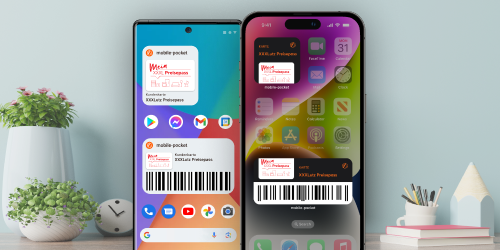Digital loyalty program: Own loyalty app or customer loyalty platform?

Plastic loyalty cards are a thing of the past: studies show that around 75% of consumers prefer mobile loyalty programs (HubSpot). The reasons are obvious: no more overstuffed wallets, convenient access to loyalty points, discounts, and personalized offers—anytime, directly on the smartphone. But companies face an important decision when implementing such programs: should they build their own loyalty app, or leverage an existing platform like mobile-pocket?
The advantages of digital loyalty programs
Before diving into the options, let’s take a quick look at the benefits: loyalty apps help businesses retain existing customers and attract new ones. They improve the customer journey through targeted communication, easy coupon redemption, and relevant offers. At the same time, brands gain valuable insights into customer behavior that can inform their marketing strategy. Not to mention: brands with well-implemented loyalty programs are recommended more often—73% of customers say so, according to the Loyalty Report 2019.
Option 1: Developing your own loyalty app – maximum individuality, but resource-intensive
Creating a custom loyalty app offers plenty of freedom. Companies can fully apply their branding, design unique features, and tailor the user experience to their target audience. However, this path comes with significant effort.
Development
Unless your company specializes in building mobile apps, you will need to find external experts to develop your solution. Keep in mind: app development takes time and generally costs far more than using an existing platform.
Marketing
Once the app is ready and listed in app stores, it must be marketed—after all, customers need to know about it. Marketing requires additional time and financial resources. The success of an app is ultimately measured by downloads and active use, so you’ll need to ensure that your customers discover it and adopt it.
For all companies?
For smaller businesses, this approach is particularly challenging. Still, for strong brands that are ready to invest and want full control over their loyalty infrastructure, an own app can be a success.
Option 2: Using an existing platform like mobile-pocket – loyalty with system
If you want to bring your loyalty program into the digital world quickly and efficiently, an established platform like mobile-pocket is the way to go. Loyalty programs can be launched here without development costs and in a short time. The advantages are clear:
- Available immediately: The mobile-pocket app is already live and used by millions of consumers worldwide.
- Wide reach: Benefit from the platform’s existing user base—even those who originally joined for another brand.
- Easy access: Customers prefer managing multiple loyalty cards in one app rather than installing ten separate ones.
- Cross-brand synergy: Retailers benefit from a network that supports both customer retention and new customer acquisition.
With mobile-pocket, you can digitize loyalty cards, award points, deliver personalized offers, and send push notifications. This way, you stay connected with your customers—without the need for your own app infrastructure.
Conclusion: Own loyalty app or customer loyalty platform?
Whether you choose to develop your own loyalty app or rely on a loyalty platform depends on your goals, resources, and desired reach. If you want maximum control and brand staging, an own app is the way to go. If you want to get started quickly and with minimal effort, mobile-pocket is the clear choice. Both approaches allow you to design loyalty in a mobile, modern, and effective way.
Do you want to know how many of your existing customers are already using mobile-pocket and waiting for you? Let’s have a no-obligation conversation.





